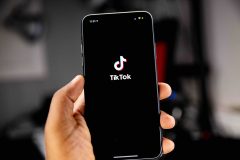TweetDeck, the leading third party Twitter client, has been acquired by Twitter – according to Techcrunch. As of writing, neither Twitter or TweetDeck have confirmed the deal. If it does go through, it will spell the end of TweetDeck’s grand plan to become the central hub for social networks. In other words, the Holy Grail of the social Web. While it started out as just a third party Twitter client, for most of its nearly 3 year existence TweetDeck has been building itself up to be a “a new browser for the real-time Web.”

Since it added Facebook support in March 2009, TweetDeck has aimed to be a central app from which people can interact with all of their social networks. That’s a potentially massive commercial opportunity for a startup. Imagine being able to control your Facebook, Twitter, MySpace, LinkedIn and other social services using the one interface. That’s precisely what TweetDeck does right now, only it’s not quite fully functional yet and people haven’t gotten used to the concept. Unfortunately, the acquisition by Twitter will put an end to TweetDeck’s ambition and we’ll have to wait for another startup to chase that Holy Grail. Here’s how this all played out and our guess at what will happen next…
2008: Multi-Columns For Twitter
TweetDesk was developed by Iain Dodsworth from England, at first as a desktop app for Twitter powered by Adobe AIR. TweetDeck was released as a public beta in July, 2008. “I originally built TweetDeck to solve my problem of being overwhelmed with Twitter,” Dodsworth later told tech blogger Louis Gray.
ReadWriteWeb reviewed TweetDeck when it launched. Frederic Lardinois noted at the time:
The major difference between TweetDeck and other Twitter clients like Twhirl, Snitter, Twitteriffic, and AlertThingy, is that it displays more than one column of information at a time. In TweetDeck, you can define columns for your replies, numerous searches in Summize, as well as groups. You can define up to 10 different columns.
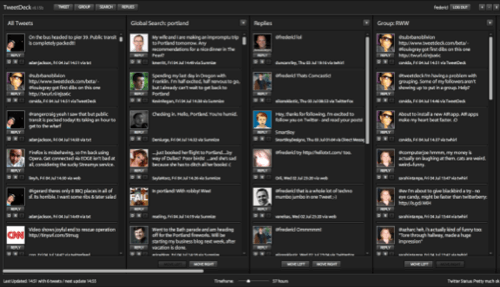
One of TweetDeck’s defining features on launch was its ability to create groups of Twitter users, to better allow you to filter your Twitter experience. Dodsworth explained to Louis Gray that “segmenting my friends out to a separate area was the catalyst for the creation of groups (a first for twitter applications afaik) and required a new approach to the UI.” This UI was inspired by financial dashboards, which Dodsworth had “been involved in building and evolving before TweetDeck.”
2009: TweetDeck Expands Beyond Twitter; to Facebook, MySpace, LinkedIn & More
Although TweetDeck was originally conceived as an application to manage your Twitter reading and writing, Dodsworth soon saw the potential to expand it to other social media services. Dodsworth wrote in mid-09 that he had “a bigger vision [for TweetDeck], to become a new browser for the real-time Web.”
To fuel that ambition, Dodsworth took seed funding from Betaworks in January 2009. We profiled Betaworks in September last year – it’s a seed-stage investor in a range of real-time web companies, such as Tumblr, Twitterfeed, Superfeedr and Songkick.
In March 2009 TweetDeck added its first integration with Facebook. It featured a new column showing status updates from your friends, along with the ability to update your Facebook status from within TweetDeck.
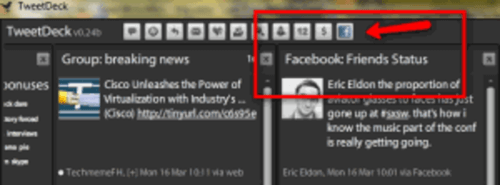
In June 2009, TweetDeck went mobile with the announcement of an iPhone app. It belatedly launched an Android version in August 2010. Version 2 of the iPhone app followed in April 2011.
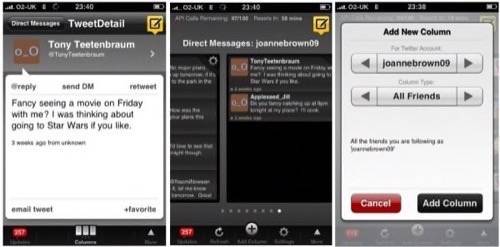
In September 2009, TweetDeck added “full powered Facebook” support. That featured the ability to view Facebook photos, videos, links, wall posts, comments and more in TweetDeck. At the same time, TweetDeck added MySpace to the app. LinkedIn was added in November that year, in-app YouTube and Flickr support in February 2010, and Google Buzz and Foursquare in May 2010.
As well as expanding its support of services other than Twitter, TweetDeck continued to adapt to whatever changes Twitter made. For example, TweetDeck added support for Twitter lists in October 2009.
At the end of the year, ReadWriteWeb named TweetDeck one of its Top 10 Consumer Web Apps of 2009.
2010-2011: More Apps (iPad, Android, ChromeDeck) & Pushing Twitter’s Boundaries
2010 was mostly focused on expanding the list of devices and platforms that TweetDeck covered.
TweetDeck for iPad arrived in April 2010, making “full use of the iPad’s large screen size and gesture-based Multi-Touch navigation.”
Another milestone was the first browser-based version of TweetDeck, with the launch of ChromeDeck in December 2010. As the name suggests, it brought TweetDeck to Google’s Chrome browser. The beta of TweetDeck Web was released in April 2011, bringing TweetDeck to other web browsers.
Also in 2011, TweetDeck turned its attention to pushing the boundaries of what Twitter offers. TweetDeck launched a feature called Deck.ly in January this year, which allows users to post tweets that are longer than the traditional 140 character limit. It’s been arguably the most controversial thing TweetDeck has done, but it may well be something that Twitter eventually adopts – whether or not it acquires TweetDeck.
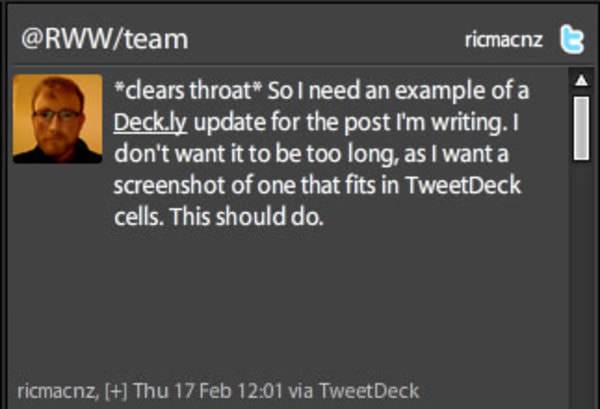
It should be noted that TweetDeck has had technical road bumps along the way, particularly dealing with Twitter’s API limits. There have also been issues with the app itself, particularly problems with large spikes in CPU and memory usage. But overall, the product has been one of the best examples of innovation in the social media era of the Web.
TweetDeck’s Search for The Holy Grail
By its 2nd anniversary in July 2010, TweetDeck had firmly established itself as the leading consumer app for Twitter. At that stage the desktop TweetDeck app had been downloaded over 15 million times
and the iPhone version over 2.5 million times.

To this day Facebook and the other non-Twitter services are still a peripheral feature of TweetDeck. Most people use TweetDeck primarily to manage their Twitter account. The Facebook integration is merely a handy, probably not well used, feature.
Nevertheless, as early as March 2009 TweetDeck was clearly building a product with a lot of promise. I’d argue that TweetDeck was building the Holy Grail of web apps in the social networking era: a single place to interact with all of your different social networks and social media services.
In July 2010, TweetDeck stated that its goal was to become a “true multi-stream” service. It claimed that “the intersection of social networks, can be infinitely greater than the sum of its parts. […] TweetDeck should be more about what your friends are saying rather than the networks they are using to say it.”
Twitter: Oh No You Don’t…
It’s a nice dream, but Twitter won’t want that reality to happen. That’s because to Twitter, the networks that people are using does matter. Specifically, Twitter doesn’t want Facebook to usurp it for real-time updates.
It’s possible that Twitter will require TweetDeck to drop support of other services entirely. More likely, Twitter will allow TweetDeck to keep developing its central social networking hub – but it will find ways to ensure that Twitter remains front and center in the app. That isn’t a big change from what TweetDeck is now, because as noted above most TweetDeck users still use the app primarily for Twitter. However, it will certainly restrict the future TweetDeck.
If TweetDeck had continued to be independent, or even if UberMedia had succeeded in its earlier bid for the product, we (the users) would eventually have gotten a much more expansive TweetDeck. Probably a more exciting product too. Definitely it would’ve been one with the potential to change the Web ecosystem.
There’s no way that will happen if Twitter buys TweetDeck, as seems likely to be confirmed any day now. That’s sad for Web innovation.



